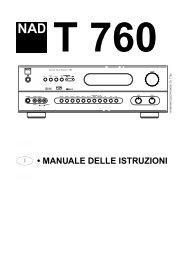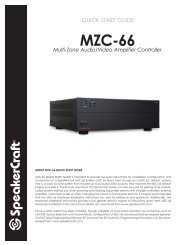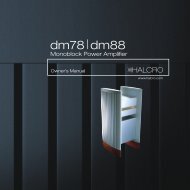Palladium® - Hi-Fi Di Prinzio
Palladium® - Hi-Fi Di Prinzio
Palladium® - Hi-Fi Di Prinzio
Create successful ePaper yourself
Turn your PDF publications into a flip-book with our unique Google optimized e-Paper software.
About Your Loudspeaker<br />
Loudspeaker Components -1<br />
An International Project<br />
The Klipsch Palladium Series has drawn on engineering, design and manufacturing resources from all over the<br />
world. In addition to our formidable team in the USA, we have used European industrial designers, British theoretical<br />
physicists and manufacturing and production specialists from China.<br />
The Palladium Series is the culmination of over 60 years of research and engineering advancements, having been<br />
designed with the most advanced computer aided design (CAD) tools available, rigorously evaluated using our<br />
own in-house proprietary software, built to the most stringent quality standards and voiced by a panel of our<br />
most experienced listeners. No Klipsch loudspeaker has ever had more care and attention to every detail lavished<br />
on it than your Palladium Series loudspeaker.<br />
Although building one pair of loudspeakers is relatively straightforward, building hundreds of loudspeakers is<br />
challenging. Measurements play an important role in analyzing loudspeaker characteristics, but the human ear<br />
is the ultimate test gear for evaluating its reproduction quality . At Klipsch, every loudspeaker design is strictly<br />
evaluated using listening tests designed to expose even the very smallest weakness. All final voicing is performed<br />
under blind conditions, using trained listeners and standard audio sound tracks selected based on their particular<br />
area of auditory excellence. All information is tabulated and reported back to the designer for analysis. In almost<br />
all cases, Klipsch products are evaluated against similarly priced competitive models. It is only in this manner that<br />
Klipsch can truly rely on the quality of feedback received, eliminating skewed data that may result due to influences<br />
caused by price, brand recognition, or visual appeal.<br />
Design<br />
The P-38F, P-37F, P-17B and P-27C are 3.5-way bass-reflex full range loudspeakers with high<br />
sensitivity and extremely low distortion. The drivers consist of either 7-or 8-inch woofers, an<br />
advanced 4.5-inch horn-loaded compression midrange driver, and a .75-inch titanium horn<br />
loaded compression dome tweeter. Each driver was designed by the Klipsch Engineering<br />
team and optimized for superior performance within each transducers bandwidth. Accurate<br />
driver design minimizes the need for driver corrections in the crossover network. Thus,<br />
the crossover is a straightforward design, with extremely high-quality components ensuring<br />
minimal insertion loss. By presenting a simple load to the amplifier, overall system performance<br />
is enhanced, a phenomenon rarely found with conventional designs. Each component<br />
used in the crossover, from the air core inductors to the polypropylene capacitors, has<br />
been selected to provide an undistorted transition between transducers. The superior components<br />
used in the Palladium Series is complemented by the unique horn and enclosure<br />
design and highlighted by the elemental performance of the industrial design. The massive<br />
laminated MDF enclosure is based on a curved non-parallel wall structure for minimal resonance.<br />
Both the tweeter and midrange compression drivers are integrated into a common<br />
molded two-element horn optimized for bandwidth, clarity, and efficiency.<br />
Bass Drivers<br />
The woofer utilizes a low mass hybrid Aluminum/Rohacell®/Kevlar® cone with an over<br />
hung voice coil. Even under massive dynamic demand, the driver retains linearity and<br />
low distortion. A three-part high intensity neodymium magnet is used with a main<br />
magnet, plus rear and forward magnets placed to ensure linearity, reduce stray magnetic<br />
energy and provide intense field strength in the voice coil gap. Dual Faraday rings on<br />
the pole piece minimize unwanted inductance, enhance heat dissipation and minimize<br />
dynamic compression.<br />
The metal cone of the woofer is damped with a composite Rohacel and Kevlar layers,<br />
which minimizes ringing and maintains low mass, eliminating breakup and other distortion<br />
products. As is the case with the midrange driver, the surround uses a flat-sided shape that keeps surroundproduced<br />
output to a minimum and preserves phase response. The cast aluminum frame assures maximum<br />
heat transfer without any reflection of the back wave of the driver that would otherwise alter the<br />
sound. An inverted half-roll low density foam rubber surround completes the clean appearance.<br />
In the P-38F and the P-37F, he woofers see differing pass bands. This preserves consistent<br />
dispersion through the critical woofer to midrange transition region and has a<br />
positive impact on off-axis performance and stereo imaging. This upper woofer covers<br />
the entire range from 30 Hz to 500 Hz, where it crosses over to the midrange driver,<br />
while the two lower woofers cover only the low and mid-bass. This “tapered-array”<br />
design delivers full bass impact, plus a graceful transition between driver groups in both<br />
tonal accuracy and dispersion.<br />
Midrange - “The midrange is where we live.” Paul W. Klipsch<br />
The inverted dome midrange driver operates from 500 Hz to 3.5 kHz and is a unique design, not found on any<br />
previous Klipsch product.<br />
The driver sensitivity of 106 dB allows minimal excursion at normal playback volume.<br />
As cone excursion reduces, so does distortion. The 4.5-inch aluminum dome is<br />
driven by 3 high temperature N35H neodymium magnets, ensuring linearity under<br />
a range of listening volumes. The pole piece is topped by a copper cap to minimize<br />
unwanted inductive components. The surround has half the density of the material<br />
typically used and thus offers reduced mass. Unlike most designs, this midrange<br />
driver delivers much more output from the dome and less from the surround. As a<br />
surround is always in motion and always changing shape, output from its surface is high in distortion—minimizing<br />
surround surface area is another means to reducing overall distortion.<br />
The midrange unit is housed in its own magnetically-shielded sealed<br />
enclosure, which isolates the driver from acoustic energy generated by the<br />
woofers. Every effort has been made to ensure great accuracy, as well as<br />
long-term durability from this unique driver.<br />
Page 14 Page 15



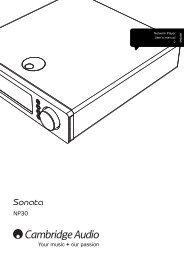
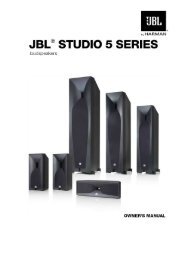

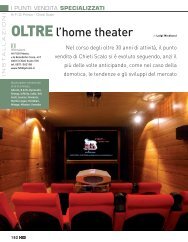
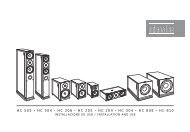
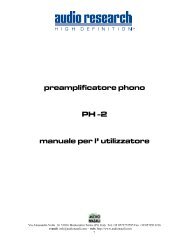

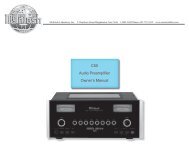
![Product Brochure [pdf] - Audio Classics](https://img.yumpu.com/22280099/1/190x245/product-brochure-pdf-audio-classics.jpg?quality=85)
